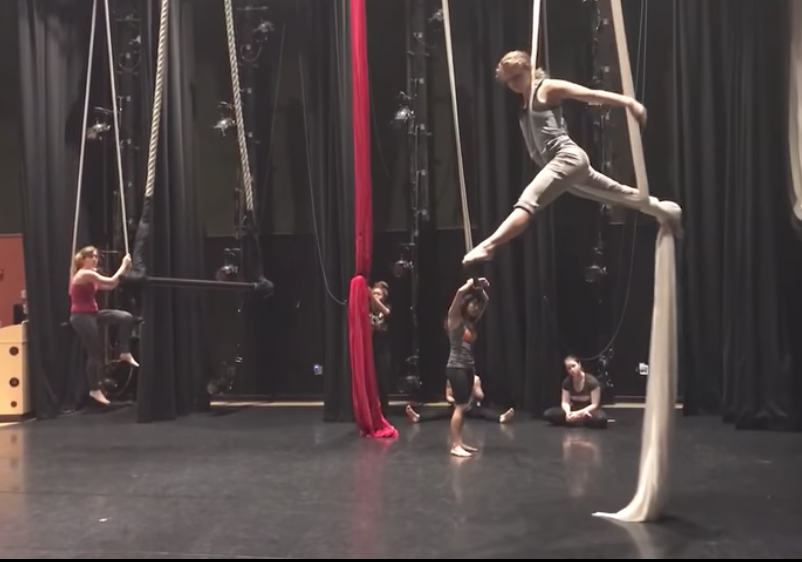
Students soar in Towson’s aerial dance studio
By: Sarah Rowan, Editor-In-Chief
It’s an early Tuesday morning at Towson University’s Center for the Arts as sophomore dance and anthropology major Eleanor Weir warms up with her class in the aerial dance studio.
Today, the class will prepare for their solo performance — their final semester project. Weir works with the trapeze, moving herself in a quick circle before using the momentum to hoist her body up onto the apparatus.
At this point, Weir is one step away from flying.
“[Aerial dance] is one of the best classes that I’ve had early in the morning,” Weir said. “It really gets me going. I don’t think anyone can really say they look forward to their 8 a.m. class as much as I do.”
A sub-genre of modern dance, aerial dance was brought to the United States between the 1960s and 1970s, as a rebellion against classical modern dance, according to instructor Jayne Bernasconi.
The choreography allows dancers to explore different ways to move their bodies in space, ultimately giving the dancer more freedom.
“Everybody wants to fly, right?” Bernasconi said. “When you have gravity, you’re always being pulled down, even though as dancers we want to defy gravity. With aerial dance, it feels like we can.”
Bernasconi is one of the pioneers of aerial dance, and her class uses her book throughout the course.
Before learning aerial dance, Bernasconi was trained in modern dance and postmodern dance. She also danced in New York for 10 years.
When she finished her time in New York, she moved to Boulder, Colorado, to dance with Frequent Flyers Productions, an aerial dance company founded by Nancy Smith in 1988.
The company has held a festival each year since 1999, where they host workshops, performances and discussions for the world’s aerial enthusiasts.
Bernasconi brought the dance genre to the Baltimore area in 1999 when she started teaching at Towson.
The University did not introduce the course into its curriculum until 2008, three years after the CFA renovation that allowed Bernasconi to hang the dance apparatuses – trapezes, silks and lyra hoops.
“Anything that gets you up in the air can be considered aerial dance,” Bernasconi said.
Weir, who has been dancing since she was two years old, said that aerial dance is one of her favorite dance classes so far.
Before coming to Towson, she was part of the University’s Community Dance Pre-Collegiate Program, which exposed her to the program before she arrived. In her senior year, she was accepted at Towson and was then approved by the dance major, a screened program.
However, she did not know how unique the aerial dance class was until she decided to take it this semester.
“Since being in the community dance program, I knew there was aerial dance here,” Weir said. “I knew it was special, but I didn’t know how special the program was.”
According to both Weir and Bernasconi, the class requires a lot of strength. All participants must be screened before they enroll, because if they are not strong enough to pull themselves onto the apparatuses, it creates safety concerns.
Weir, who considers herself lightweight and not muscular, said that as long as a participant can do a push-up, they should be able to perform well in the class and that their strength will increase throughout the semester.
“I’m able to lift my own body weight, but I can’t do a pull-up all the way,” Weir said. “I’m able to use the strength and physics that’s involved, and what I actually found was that my strength increased just learning how to do the movements.”
Weir said that the class is perfect for anyone who has played sports, done yoga or participated in any opportunity that would allow somebody to be in tune with their body.
“If you know how to move your body, it’s a good class to take,” Weir said. “If you really want to do it, I’d say go for it. Maybe take a yoga class as well to help build up your body.”
To Weir, the class provides her an opportunity to feel weightless, to fight against gravity and to explore different ways to move in another kind of space.
“I guess people who take it a lot are people who almost want to feel like they’re flying,” Weir said. “I particularly like it because it opens all this new space as a dancer. Being limited to the ground and limited to gravity, you’re able to fight against it.”

